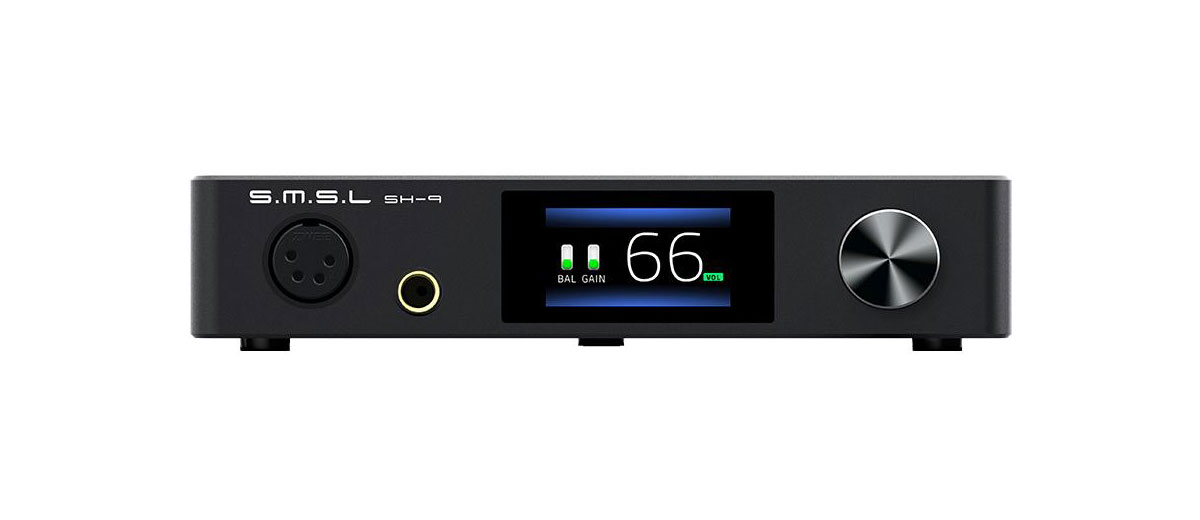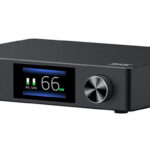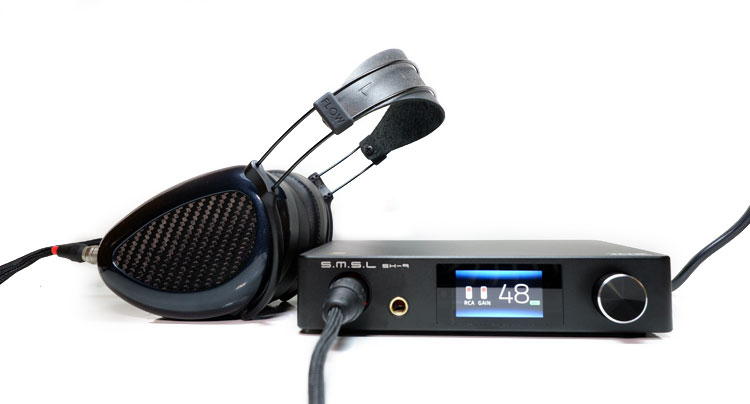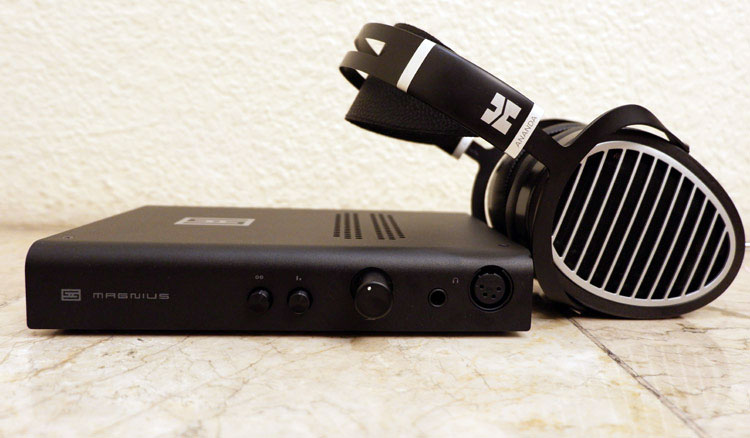The SMSL SH-9 is a THX AAA-888 balanced headphone amplifier featuring 2 mono amplification blocks capable of up to 3W into a 32Ω load. It is priced at $289.99
Disclaimer: The SMSL SH-9 sent to us for this review is a sample in exchange for our honest opinion. We thank Shenzhen Audio for giving us this opportunity.
To read more about SMSL products we have reviewed on Headfonics click here.
Note, this 2-page review follows our new scoring guidelines for 2020 which you can read up on here.
Not long after SMSL gave us their excellent SU-9 DAC, along comes the SH-9 amplifier which, in a way, is rather logical, particularly for those looking for an aesthetically pleasing compact and stackable system.
It also has a similar design aesthetic to their M400 DAC but with those all-important matching SU-9 dimensions. However, more than this, SMSL has thrown in a balanced capable THX AAA-888 amplification topology and priced it rather tantalizingly at $289.99. Now that should turn some heads.

Tech Inside
When I first glanced at the SH-9 spec sheet, I was reminded a lot of a similar SMSL product, the SP200. They have a similar set of inputs, outputs, and specifications, including output power specifications.
Also, they are both advertised as having a THX AAA-888 amp stage, so my initial reaction was that there may well have been a lot of ‘legacy thinking’ here between the two models.
Looking deeper into the specs in the box though, I was happy to be proven wrong. While it seems that the SH-9 is not balanced in terms of differing power rates from their single-ended inputs, the flipside is that the balanced design here is very good for noise with a THD below 0.00006%.
Volume control on the SH-9 is done by relay volume control with 256 discrete steps. This makes volume matching between the left and right channels perfect, even down to the lowest of volume steps. I am surprised that SMSL could cram a relay volume control into the SH-9 since this was previously reserved for higher-end gear only.
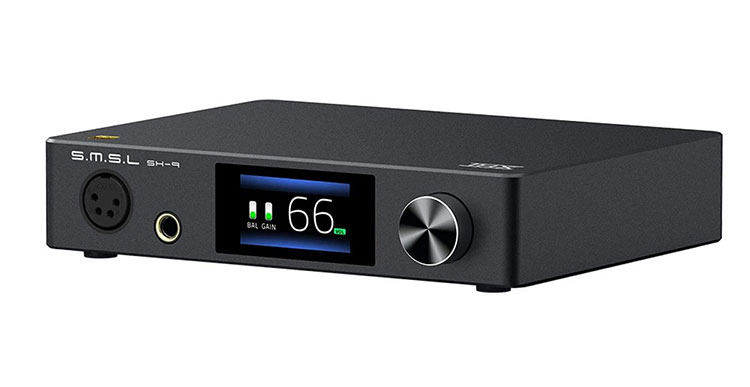
Design
The SH-9 is aesthetically matched with the SU-9. Both chassis are of the same size, where the control knob and the 1.9” TFT display are both located in the same spot. Up front, the biggest difference between the 2 devices is that the SH-9 has 2 more holes for the 4-pin XLR connector and the ¼” single-ended connection.
At the rear of the SH-9 are the input connections that include a pair of balanced 3-pin XLR connections, and a pair of RCA single-ended connection. I would have wanted to see a pair of pre-amp outs with the SH-9. This would have been a great addition since the pre-outs would also utilize its precision relay volume control.
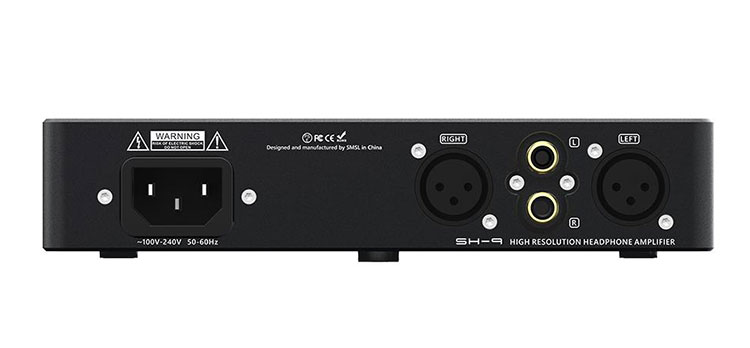
The power input socket is your standard IEC power connector that you can easily swap out with a higher-end power cable.
Instead of a physical gain switch and input selector, the selection is done via the menu system. The menu system is pretty straightforward, and it’s just a matter of clicking on the volume wheel and browsing through the different options available which include input selection and gain control.
I would still have wanted to see a physical gain switch though, as it would be more convenient to lower the volume if I find the volume too loud upon switching into high gain.
Remote control
Staying within the product line of SMSL does have its perks. I found that the remote control is interoperable between the SU-9 and the SH-9. When trying to control the SU-9, simply click on the “C” button on the remote control, and it will let you control the SU-9 with its different functions.
Clicking on the “B” button would switch the remote over to controlling the SH-9. I found this particularly useful, as the input selection and the gain both have dedicated buttons. This then gives me the ability to quickly adjust the volume of the SH-9 if I were to suddenly switch over to high gain.
Going into the menu is also possible with the remote, and this allows me to adjust brightness and volume mode. This mode allows for the conservation of the relays that switch on the resistor ladders for precision volume control.
While I was missing a physical gain switch, I like how SMSL compensated for this by adding a dedicated button for gain.
Package & Accessories
The packaging is pretty much the same as the one that came with the SU-9. Inside the box are foam inserts that keep it protected while the product is being transported or stored.
The accessories that were included what I would call standard for a mid-range amplifier setup. That means a power cable, the manual, and of course the remote control.
Sound Impressions
Summary
This is a THX AAA amplifier, where AAA stands for Achromatic Audio Amplifier. The intent of the design is to create an amplifier that doesn’t color the sound, basically a wire with gain.
So when I plugged the SH-9 into my system, this was what I was expecting and I was not disappointed. The SH-9, to my ears, was as flat as any amplifier can be. It did not add anything in terms of tonality nor did it remove anything from what was being produced by the upstream DAC.
While listening to pop music, I found that the SH-9 performed the way it should perform and did not change what I was expecting from the music.
The start of Drink Up by Train still retained the sub-bass rumble that I’ve come to expect. Textured nuances in vocals were generally retained also. A very transparent rendition.
As Gotta Be Patient by Michael Bublé played, it was easy to perceive the textured vocal of Michael Bublé’s singing without any undue coloration being introduced into the signal. The treble sparkle in the track was generally still retained, and cymbals passages still had the same amount of energy that I’ve become accustomed to.
Timbre
The timbre of the music is in no way changed by the SH-9 and it lives up to the AAA moniker that it carries with what I have always referenced as a wonderfully transparent performance.
When it comes to amplifiers though, tonality and distortion numbers should not be the sole consideration. Those are the fundamentals of what makes an amplifier sound right, but things like timing and dynamic range play a considerable role in making it a more engaging listening experience.
Male vocals like the one that can be heard in Isn’t She Lovely by Lingston Taylor sounded quite liquid. Textural nuances were present, but I also found the vocals to have a slightly thicker quality to them, giving the vocalist a fuller quality overall.
Piano tones on the other hand take on a fuller warmer timbre as well. I listened to River Flows in You by Yiruma and found that the sound tended to sound smoother overall. Although each note remained distinct, the way the song just sounded slightly more velvety.
Staging
When it comes to staging width, I found that the SH-9 can perform quite well. Imaging cues can stretch pretty wide from many angles so long as the headphone can keep up with it. When I listened to chamber music, I am quickly able to discern the size of the room where they recorded the music.
While the SH-9 can project a relatively large soundstage is not unendingly expansive. The staging extension is fairly concrete at the outer limits as if there is a wall that creates a hard boundary rather than diffuse fade into nowhere.
Imaging is also accurate on the SH-9. Listening to binaural recordings, I found that the center guitar on Amber Rubarth’s Washing Day is very accurately placed in front of the listener.
When it comes to staging depth the SH-9 can either be very intimate or very wide. In between the 2 extremes, the soundstage can often sound a bit empty.
This is quite prominent in Sara K.’s If I could sing Your Blues, where there’s a trumpet that pans to the right. The trumpet should sound like it’s a few meters away but instead sounds almost as intimate as Sara K.’s own vocal performance which is not quite right for me.
Although the soundstage is quite wide, and imaging is fairly accurate in terms of direction, I would have wanted to hear a bit more layering and depth within the soundstage.
Synergy
The most obvious source pairing is the SU-9 DAC and both look great together as a stack. For those who would also like their inputs and outputs to align perfectly the 2 devices align perfectly at the back as well. To add to that, they can share a single remote control which is a plus from a convenience standpoint.
Combined the best synergy I got was with the crystal 3 sound color setting on the SU-9. This tended to make the sound come out a bit sharper and with more bite, which the SH-9 honestly needs a bit of.
With sensitive IEM’s there was no hiss or volume imbalance even on high gain, thanks to the precision relay volume control. While harder to drive headphones performed quite well on the SH-9.
Headphone Pairings
The headphone pairing for the SH-9 is pretty straight forward. The SH-9 did well with most of the things that I threw at it.
Using the HD600, the SH-9 had a lot of headroom and excellent dynamic range. The SH-9 could provide enough voltage for the 300Ω dynamic driver to sound correct. The midrange retained its smooth and euphonic character, while the rest of the frequency response is tonally accurate and true to how the HD600 should sound with a quality solid-state amplifier.
With the less efficient Dan Clark Audio AEON Closed RT, I found that the SH-9 could deliver some quality current levels so there is no issue in terms of volume headroom with this pairing At no point did I find the SH-9 to underpower the AEON, as the bass on the AEON was left intact, while the treble remained clean and smooth.
The SH-9 will make a good pairing with almost any headphone, regardless of its impedance or power requirements. One thing to note though is that when the SH-9 has been running for at least 1 hour, it does heat up a bit, but it never seems to become dangerously hot.
Select comparisons
Topping L30
Technical
At first glance, the L30 will naturally have a few fewer features when compared to the SH-9, so let’s get those out of the way. First thing is that the L30 doesn’t have a display, instead, toggle switches take its place.
Also, volume control on the L30 is done by a simple potentiometer, which seems to turn a bit too easily, and of course, the L30 doesn’t have any remote control. And finally, the L30 can only output 3.5W@16Ω, a bit more than half the rated output of the SH-9.
However, the L30 does have a few features that the SH-9 doesn’t have. The first being the pre-amp output at the back. Also, the L30 has 3 gain settings instead of the 2 that are available on the SH-9.
The L30 only has single-ended connections available in front and at the back, while the SH-9 has some balanced connectors both as inputs and as outputs. While the balanced connectors on the SH-9 do not differentiate on the power they do generate an impressively lower noise floor.
Topping’s NFCA topology-based L30 does very well for noise at 0.00007% THD but the THX AAA 888 based SH-9 has an edge at 0.00006% THD. Both, however, are below the audible threshold.
Performance
Topping’s NFCA topology, as well as the THX AAA topology, are both designed to be achromatic, and I believe that the implementation of these topologies on the L30 and the SH-9 respectively was done quite well. I found that neither of the 2 amplifiers colored the sound in any significant manner.
Using choral music on the 2 amplifiers, the SH-9 is just a bit more realistic sounding whereas the L30 made the choir staging slightly more boxed in. The SH-9 has the more natural presentation of the 2 soundstages. Elements or imaging cues are placed a bit further out and more accurately than on the L30.
The SH-9 also has an edge for detail retrieval when compared to the L30. Drum impacts were just a bit more immediate on the SH-9 compared to the L30’s more liquid presentation. Vocal depth was more apparent with the SH-9, whereas the L30 just felt a bit smoothed over.
Selling for a bit less than half the asking price of the SH-9, the L30 does make a good value proposition. However, the L30 might seem to be a bit compromised in terms of general detail retrieval when compared to the SH-9.
Schiit Magnius
Technical
Unfortunately, I sold off my SP200 a few months ago since I ended up liking how the Magnius sounded comparatively.
In general, I liked the Magnius more because of its more energetic presentation. However, the Magnius is better as a balanced amplifier since the single-ended output is quite a bit noisier.
These are two fairly different amps on a technical level. The SH-9 has the benefit of having a screen 1.9” display as well as a remote control for input and gain control whereas the Magnius is more basic in terms of mechanical switching.
Looking at the power specifications, the 2 amplifiers have the same rated power output of 6W@16Ω in balanced mode. However, at the 32ohm load, the Magnius is still quite powerful at 5w whereas the SH-9 drops off to 3W on the same load. That additional power from the Magnius is evident right up to 600Ω at 500mW per channel compared to just 220mW on the SH-9.
Volume Control
Another thing to note between the 2 amplifiers is that they both boast of good quality volume control. The Magnius uses a 27mm Alps potentiometer, while the SH-9 offers a relay-controlled resistor network volume control.
Both methods are theoretically sound, but in practice, I found that the SH-9 has better tracking between the left and right channels, especially when driving more sensitive loads.
I mentioned earlier that having no pre-outs with the SH-9 was something of a missed opportunity, because of the highly precise channel matching via its volume control. This might come in handy, similar to what can be found on the Magnius.
The SH-9 would have had better use of a pre-amp section because of the remote control but as long as it’s connected to its brother the SU-9 pre-amp controls can be done via the SU-9 instead.
Performance
When I listened to the 2 amplifiers, I was expecting to like the Magnius more, because of my perceived similarity between the SP200 and the SH-9. However, this time it’s not as clear cut as it was when I compared the Magnius to the SP200.
The Magnius and the SH-9 both have an equally flat tonality, which is what they both are designed to provide. Beyond that, however, the Magnius is the punchier and more dynamic of the 2 amplifiers. For example, you can differentiate the volume of a drum hit and its fade to whisper on the Magnius far more easily.
The soundstage on both amplifiers are about equal, but the SH-9 felt like it had a less expansive soundstage. What I loved about the SH-9 though is how flowy the SH-9 can be, making piano music sound more liquid and dreamier.
While the Magnius edges the SH-9 on dynamics, the SH-9 is simply the more versatile choice of the 2 amplifiers. The Magnius needs a specific circumstance to be relevant, namely having balance terminated headphones that are not too sensitive.
The single-ended performance of the Magnius is nothing special. Whereas the SH-9 can drive even the most sensitive IEMs, or headphone up to the hardest to drive headphones with both single-ended and balanced terminations.

Our Verdict
On paper, the SH-9 may seem to have a very similar set of specs with the cheaper SMSL SP200 and it does lack a pre-amp but it does have quite a few excellent things going for it.
The SH-9 had much better volume control that gives it perfect volume matching down to the lowest setting. It also has a remote control and a chassis that will make it a perfect complement to the SU-9. The noise floor is excellent on that THX amp with an incredibly smooth yet linear signal.
Most of all, it has excellent power so ideal for a lot of headphone users out there. Even IEMs will work just fine with very little noise.
With an updated set of features and a refined overall sound, I can see why the SH-9 would make a great amplifier for any desktop, especially ones that are already rocking a SU-9 DAC.
SMSL SH-9 Technical Specifications
- Inputs: Balanced x1, Unbalanced x1
- Outputs: Balanced x1, Unbalanced x1
- Output Power: 6W x 2(16Ω), 3W x 2(32Ω), 440mW x 2 (300Ω), 220mW x 2 (600Ω)
- THD+N: -123dB, 0.00006% (A-Weighted)
- Input Impedance: 47kΩ
- Output Impedance: Near 0Ω
- Power supply voltage/frequency: AC100-240V, 50-60 Hz
- Power consumption(EN60065): 24W
- Power consumption in standby mode: <0.1W
- Size: 187.5x154x40(mm)
- Packing size: 282x232x79(mm)
- Weight: 790g

